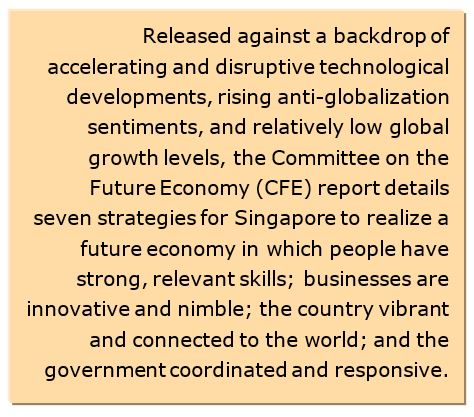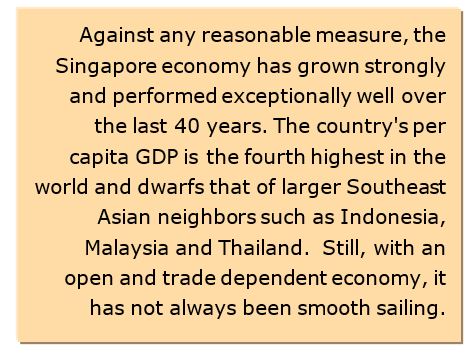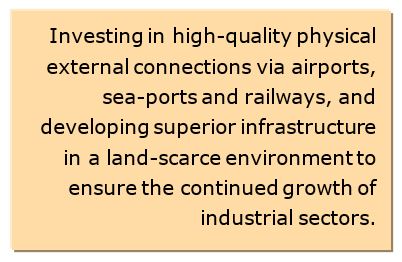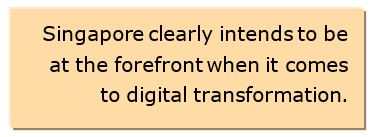

In February 2017, the Committee on the Future Economy (CFE) released a set of recommendations for how Singapore 
A year in the making, the CFE report was produced by a 30-strong committee comprised of government ministers, senior company executives, and union representatives, and facilitated by sub-committees and working groups. Its recommendations were delivered in the form of seven strategies. These take into account challenges to the economy and craft a way forward for Singapore to build on its previous successes and some existing initiatives.
With Singapore moving into the realm of a developed rather than a developing economy, the years of 5 percent or more GDP annual growth rates are clearly a thing of the past. The Committee on the Future Economy believes that adoption of its recommended strategies will enable average annual growth of 2 to 3 percent for the country.
Helming a country with no natural resources, small land size, and a population of just four million, Singapore governments have played a highly active role in planning and guiding the economy since independence in 1965.
In the late 1960s and onwards, vigorous foreign direct investment efforts helped encourage many multinational companies to select Singapore to site manufacturing facilities as well as administrative headquarters for the Southeast Asia or wider Asia region. Companies were also attracted by the widespread use of English, strong rule of law, superior infrastructure, and an increasingly educated and skilled workforce. Examples include ExxonMobil, HP, Philips, Seagate, and Shell.
The government also established local industry players in chosen sectors through public funding and, over time, many of these companies became highly successful, employing thousands of people, and later venturing abroad for further growth opportunities. Examples include Keppel Corporation (oil rig construction and shipbuilding), PSA (ports), Sembcorp Industries (power and water utilities), and ST Engineering (aerospace and electronics).

Still, with an open and trade-dependent economy, it has not always been smooth sailing. But the Singapore government is usually quick to take action as needed to prevent untoward economic decline and its negative spinoffs. For example, the response during the 2009 Global Financial crisis was a multi-billion-dollar stimulus (called the Resilience Package) comprising elements such as a jobs credit scheme to encourage companies not to shed workers, corporate and personal tax reductions, and the bringing forward of large infrastructure projects.
At certain junctures, the government has sought to go beyond immediate policy remedies and instigate full-blown economic reviews, of which the Committee on the Future Economy (CFE) report is the latest. Previous reviews include the Economic Committee (1986), Economic Review Committee (2001), and Economic Strategies Committee (2009).
Unlike in 2009, no single macroeconomic event triggered the formation in 2016 of the Committee on the Future Economy. Rather, it was clearly necessary to re-examine Singapore's options and opportunities against a backdrop of accelerating and "disruptive" technological developments, developed rather than developing world growth rates, and labor force disruptions emanating from a rapidly ageing population and lower inflows of foreign workers.
Hence the broad remit for the Committee on the Future Economy (CFE) was to review Singapore’s economic strategies, build on the previous Economic Strategies Committee’s work, and take a fresh look to address new challenges. In all, more than 9,000 people contributed ideas for the direction the Singapore economy should take on its next journey.
The 109-page CFE report details seven strategies to realize a future economy where people have strong, relevant skills and continue to learn, businesses are innovative and nimble, the country vibrant and connected to the world, and the government coordinated and responsive. These seven strategies are summarized below.
Against a backdrop of negative sentiments against globalization in some areas of the world, Singapore should not only resist protectionist urges but strive to deepen linkages with current overseas partners while seeking opportunities in new markets.
In addition to trade liberalization and global economic integration, which are logical paths for Singapore to pursue and encourage given its open and trade-dependent economy, building strong connections with global innovation and technology hubs will improve harnessing of new ideas and technologies.
The rapid pace of technological development, means that people not only need to develop deep skills to stay relevant, but must enhance these throughout their working lives rather than just relying on initial academic qualifications.
As well as academic institutions offering more modularized and technology-enabled programs, employers can help workers stay current by giving greater emphasis to in-house training. Employers should also ensure they promptly utilize the new skills acquired by staff.
As global competition intensifies, growing and deepening capabilities among businesses is critical to Singapore's future success. While government agencies already have a range of support schemes to help enterprises innovate and improve productivity, a more customized approach based on specific needs and current growth stage can help accelerate the scaling up process.
And to provide more growth capital for firms, the government should facilitate private sector funding by simplifying the regulatory framework for venture capital firms and encourage more private equity firms to set up operations in Singapore.
With digitization transforming industries and creating new ones, and with data becoming an increasingly important source of comparative advantage, Singapore needs to be ready to leverage opportunities offered by the digital economy.
As well as encouraging the adoption of digital technologies across the economy, in particular among the smaller and medium enterprises (SMEs), Singapore needs to build strong capabilities in these transformative technologies. One recommendation: the government should establish a dedicated program office to support companies' digital efforts by co-developing flagship data science projects that will have positive demonstrative effects on other enterprises.

Creating clusters of mutually-reinforcing economic activities, such as the Jurong Innovation District, which will be a hub for advanced manufacturing, urban solutions, and clean technologies; should help encourage partnerships through the close proximity of companies engaged in synergistic activities.
Industry Transformation Maps (ITMs) are roadmaps for plotting the way ahead for 23 selected industries so they can achieve their potential. Each ITM integrates six aspects: growth and competitiveness; innovation; internationalization; productivity; jobs and skills, and government support. The tailored ITMs recognize the varying development levels of different industries and that each has its own challenges and opportunities.
For example, some sectors in Singapore like construction and food service require large numbers of low-skilled and usually foreign workers, and the ITM would focus on the need to upgrade productivity and upskill jobs. While, in the past, Singapore has been accused of "picking winners" with its industrial policies, the idea of the Industry Transformation Maps is to build capabilities and enable both enterprises and workers to succeed in the open market.
As Singapore moves forward over the next decade, to better understand the future challenges and harness emerging opportunities, it is the role of government to create an environment in which enterprises, unions, trade associations, and individuals can come together in an atmosphere of trust.
And given this era of job uncertainties and dislocation, unions should continue to work with and not against companies and the government to help workers upskill and transition to the jobs of the future. The government should also work to create a more flexible regulatory environment, one that encourages innovation and risk-taking, and streamline the (rather bewildering) number of support schemes for companies.
Within Southeast Asia and even globally, Singapore has always prided itself on trying to be the best. Some examples include the world's best airport (in numerous surveys), top maritime capital (Menon Report), and best provision of education (OECD).
This ongoing search for excellence is no doubt driven by a sense of vulnerability from its small size and population, lack of hinterland and natural resources, and the geopolitical reality of being the only majority ethnic Chinese country in a region that includes the world's most populous Muslim nation, Indonesia. Co-opting Andy Grove's mantra, Singapore does need to be rather paranoid to survive.
Thus, it should be no surprise that Singapore is generally quick off the mark to face and contain any threats to its economy and create and develop new paths to success as circumstances change and evolve. The work of the Committee on the Future Economy and its recommendations should thus be viewed in that context.

Other clear technology opportunities come from the continued importance afforded to building high-quality infrastructure, such as logistics and transportation facilities, and the emphasis on boosting productivity and the importance of innovation within the framework of the Industry Transformation Maps.
In addition, with the general worldwide dearth of high-tech skills, the efforts outlined to ensure that Singapore workforce has, and continues to develop, the requisite skills needed by a modern, technology-driven economy should encourage companies to select Singapore to site advanced manufacturing and higher-level R&D activities.
If you would like to buy this report or obtain information about how to become a client, please Contact Us
Keywords: Singapore, Committee on the Future Economy, CFE, ARC Advisory Group.

